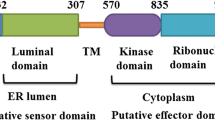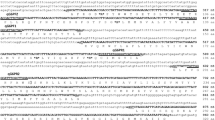Abstract
Trehalose is an important disaccharide and plays a key role in many organisms under different stress conditions. In the study, a gene (FcTPS) encoded trehalose-6-phosphate synthase was reported from Chinese shrimp, Fenneropenaeus chinensis. The full-length cDNA of FcTPS is 3,281 bp including a poly A-tail of 20 bp, encoding a putative protein of 844 amino acids. The predicted protein contains a glycol_transf_20 domain and a trehalose_PPase domain. Genomic structure of FcTPS is composed of three exons with 192, 157 and 2,912 bp and two introns with 1,057 and 568 bp. In the second intron, four different SSRs are found. Transcripts of FcTPS gene are constitutively expressed in various tissues, with strongest level in hepatopancreas. After the shrimp were challenged with WSSV or Vibrio and the expression of FcTPS in hepatopancreas were analyzed using real-time PCR, the result showed that FcTPS transcript was down-regulated significantly in response to the challenge of Vibro at the early of 5 h post-challenge and then up-regulated significantly at 14 h. In addition, the expression of FcTPS showed the same result after the shrimp were challenged with WSSV. These results provide some new information about the tissue distribution, expression profiles and potential function of the trehalose-6-phosphate synthase in shrimp.





Similar content being viewed by others
References
Chung JS (2008) A trehalose 6-phosphate synthase gene of the hemocytes of the blue crab, Callinectes sapidus: cloning, the expression, its enzyme activity and relationship to hemolymph trehalose levels. Saline Syst 4:18. doi:10.1186/1746-1448-4-18
Tang B, Chen J, Yao Q, Pan Z, Xu W, Wang S, Zhang W (2010) Characterization of a trehalose-6-phosphate synthase gene from Spodoptera exigua and its function identification through RNA interference. J Insect Physiol 56:813–821. doi:10.1016/j.jinsphys.2010.02.009
Elbein AD, Pan YT, Pastuszak I, Carroll D (2003) New insights on trehalose: a multifunctional molecule. Glycobiology 13:17R–27R. doi:10.1093/glycob/cwg047cwg047
Zhang N, Wang F, Meng X, Luo S, Li Q, Dong H, Xu Z, Song R (2011) Molecular cloning and characterization of a trehalose-6-phosphate synthase/phosphatase from Dunaliella viridis. Mol Biol Rep 38:2241–2248. doi:10.1007/s11033-010-0354-1
Wang G, Zhao G, Feng Y, Xuan J, Sun J, Guo B, Jiang G, Weng M, Yao J, Wang B et al (2010) Cloning and comparative studies of seaweed trehalose-6-phosphate synthase genes. Mar Drugs 8:2065–2079. doi:10.3390/md8072065
Vogel G, Fiehn O, Jean-Richard-dit-Bressel L, Boller T, Wiemken A, Aeschbacher RA, Wingler A (2001) Trehalose metabolism in Arabidopsis: occurrence of trehalose and molecular cloning and characterization of trehalose-6-phosphate synthase homologues. J Exp Bot 52:1817–1826
Cai Z, Peng G, Cao Y, Liu Y, Jin K, Xia Y (2009) Trehalose-6-phosphate synthase 1 from Metarhizium anisopliae: clone, expression and properties of the recombinant. J Biosci Bioeng 107:499–505. doi:10.1016/j.jbiosc.2009.01.007
Kwon HB, Yeo ET, Hahn SE, Bae SC, Kim DY, Byun MO (2003) Cloning and characterization of genes encoding trehalose-6-phosphate synthase (TPS1) and trehalose-6-phosphate phosphatase (TPS2) from Zygosaccharomyces rouxii. FEMS Yeast Res 3:433–440
Zhang JQ, Li FH, Wang ZH, Zhang XJ, Zhou Q, Xiang JH (2006) Cloning, expression and identification of ferritin from Chinese shrimp, Fenneropenaeus chinensis. J Biotechnol 125:173–184. doi:10.1016/j.jbiotec.2006.03.010
Wang B, Li F, Dong B, Zhang X, Zhang C, Xiang J (2006) Discovery of the genes in response to white spot syndrome virus (WSSV) infection in Fenneropenaeus chinensis through cDNA microarray. Mar Biotechnol 8:491–500. doi:10.1007/s10126-005-6136-4
Priya TAJ, Li FH, Zhang JQ, Yang CJ, Xiang JH (2010) Molecular characterization of an ecdysone inducible gene E75 of Chinese shrimp Fenneropenaeus chinensis and elucidation of its role in molting by RNA interference. Comp Biochem Phys B 156:149–157. doi:10.1016/j.cbpb.2010.02.004
He N, Qin Q, Xu X (2005) Differential profile of genes expressed in hemocytes of white spot syndrome virus-resistant shrimp (Penaeus japonicus) by combining suppression subtractive hybridization and differential hybridization. Antiviral Res 66:39–45. doi:10.1016/j.antiviral.2004.12.010
Kumar S, Tamura K, Nei M (2004) MEGA3: integrated software for Molecular Evolutionary Genetics Analysis and sequence alignment. Brief Bioinform 5:150–163
Yang CJ, Zhang JQ, Li FH, Ma HM, Zhang QL, Priya TAJ, Zhang XJ, Xiang JH (2008) A toll receptor from Chinese shrimp Fenneropenaeus chinensis is responsive to Vibrio anguillarum infection. Fish Shellfish Immunol 24:564–574. doi:10.1016/j.fsi.2007.12.012
Shapiro MB, Senapathy P (1987) RNA splice junctions of different classes of eukaryotes: sequence statistics and functional implications in gene expression. Nucleic Acids Res 15:7155–7174
Pan D, He N, Yang Z, Liu H, Xu X (2005) Differential gene expression profile in hepatopancreas of WSSV-resistant shrimp (Penaeus japonicus) by suppression subtractive hybridization. Dev Comp Immunol 29:103–112. doi:10.1016/j.dci.2004.07.001
Peregrino-Uriarte AB, Muhlia-Almazan AT, Arvizu-Flores AA, Gomez-Anduro G, Gollas-Galvan T, Yepiz-Plascencia G, Sotelo-Mundo RR (2012) Shrimp invertebrate lysozyme i-lyz: gene structure, molecular model and response of c and i lysozymes to lipopolysaccharide (LPS). Fish Shellfish Immunol 32:230–236. doi:10.1016/j.fsi.2011.10.026
Becker A, Schloder P, Steele JE, Wegener G (1996) The regulation of trehalose metabolism in insects. Experientia 52:433–439
Acknowledgments
This work was supported by the National Natural Science Foundation of China (Grant No. 311720449), National High Technology Research and Development Program (Grant No. 2012AA10A401), and the Scientific Research Foundation for the Excellent Middle-Aged and Youth Scientists of Shandong Province of China (Grant No. BS2010SW039).
Author information
Authors and Affiliations
Corresponding author
Rights and permissions
About this article
Cite this article
Zhang, J., Wang, J., Li, F. et al. A trehalose-6-phosphate synthase gene from Chinese shrimp, Fenneropenaeus chinensis . Mol Biol Rep 39, 10219–10225 (2012). https://doi.org/10.1007/s11033-012-1897-0
Received:
Accepted:
Published:
Issue Date:
DOI: https://doi.org/10.1007/s11033-012-1897-0




